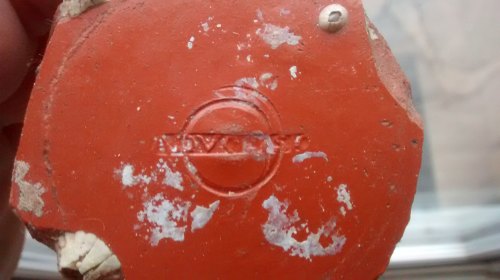
Image use policy
Our images can be used under a CC BY attribution licence (unless stated otherwise).
FOOD AND DRINK SERVING CONTAINER
Unique ID: MAS-100010
Object type certainty: Certain
Workflow
status: Published ![]()
This is a group of nine sherds of ceramic, of which six are samian ware (also called terra sigillata). Samian pottery is a mould-made, glossy red, mass-produced, fine tableware. It was first manufactured in northern Italy at the end of the 1st century BC, however by AD 43 production had moved to Gaul (France). The production of samian ware ended around AD 260.
The following interpretation is based on the photographs associated with this record. An examination of the fabric and surviving decorative elements may provide further information on the region of manufacture or production centre and the identity of the potter, which can indicate a more accurate date of production.
Images 1 & 4:
A sherd of the base of a samian vessel, form unknown. The easily legible name-stamp is that of Advocisus who worked at Lezoux (Central Gaul) c. AD 160 to AD 200.
Images 2 & 5:
Three decorated samian sherds that all appear to be from form 37 bowls and are suspected to be from Central Gaul. All three have surviving decorative elements.
Image 3:
This smaller samian base sherd was probably part of a cup form. Interestingly, it has been observed that samian cup forms are very strongly represented in the Essex region, especially at rural sites, to a degree not seen elsewhere (Willis 2004).
Image 5 (top right):
The form of this non-samian sherd suggests that it is of 1st or earlier 2nd century AD date.
Images 6 & 8:
This is a Roman jug rim that was probably made in Britain.
Image 7:
This is the rim of an imported Roman amphora. Amphora are a type of wheel-thrown container used for the transport and storage of liquids and dry products. As an inexpensive container for the transport of goods, they were broken up and discarded at their destination rather than being reused.
Notes:
Samian vessels are known to occur in structured deposits associated with water, and therefore are interpreted to have played a role in the activities undertaken at such locations (Willis 2004). In some instances, in Britain, samian ware was a selected and prominent element within assemblages deposited in wells or shafts and other wet places (Willis 2004).
Class:
Food preparation and consumption
Sub class: Container by function
Subsequent actions
Current location of find: With finder
Subsequent action after recording: Submitted as wreck to the Receiver of Wreck
Wreck details
Droit number: 037/17
Chronology
Broad period: ROMAN
Period from: ROMAN
Period to: ROMAN
Date from: Circa 100 BC
Date to: Circa AD 300
Dimensions and weight
Quantity: 9
Discovery dates
Date(s) of discovery: Wednesday 14th September 2016
Personal details
Found by: This information is restricted for your login.
Recorded by: M F
Secondary identifier: V L
Other reference numbers
Droit ID: 037/17
Materials and construction
Primary material: Ceramic
Manufacture method: Moulded
Decoration style: Other
Completeness: Fragment
Spatial coordinates
4 Figure: TQ8182
Four figure Latitude: 51.50793861
Four figure longitude: 0.60677648
1:25K map: TQ8182
1:10K map: TQ88SW
Display four figure position on What3Words
Grid reference source: From finder
Unmasked grid reference accurate to a 1 metre square.
References cited
- Willis, S, 2004 Samian Pottery, a Resource for the Study of Roman Britain and Beyond: The results of the English Heritage funded Samian Project. An e-monograph Kent : Internet Archaeology, ,
Similar objects

Find number: MAS-100020
Object type: JAR
Broadperiod: POST MEDIEVAL
Pottery sherd: a rim sherd from a Post Medieval glazed redware flanged bowl with a horizontal looped side handle. The sherd dates to the 17th/…
Workflow: Published![]()

Find number: MAS-D100199
Object type: BOTTLE
Broadperiod: NINETEENTH CENTURY
This find is a small medicine style bottle in green glass. No scale was provided but these vessels are usually 160 - 190 mm in overall height.…
Workflow: Published![]()

Find number: MAS-D100128
Object type: HINGE
Broadperiod: NINETEENTH CENTURY
This record refers to the metal hinge and attached timber shown in the top left corner of image one, the other finds are dealt with under sepa…
Workflow: Published![]()








